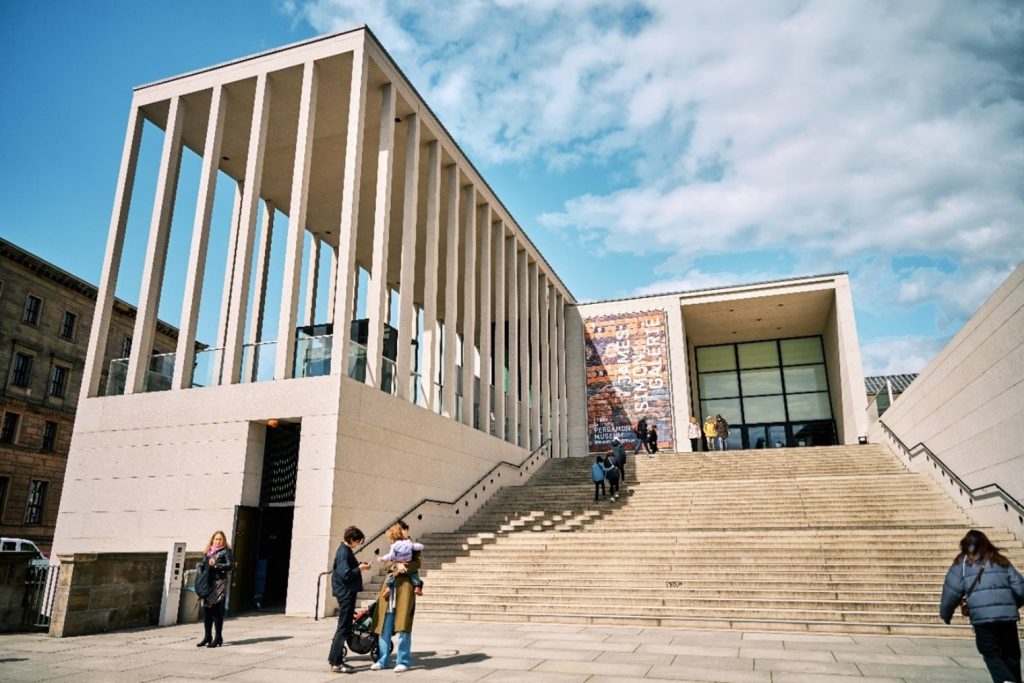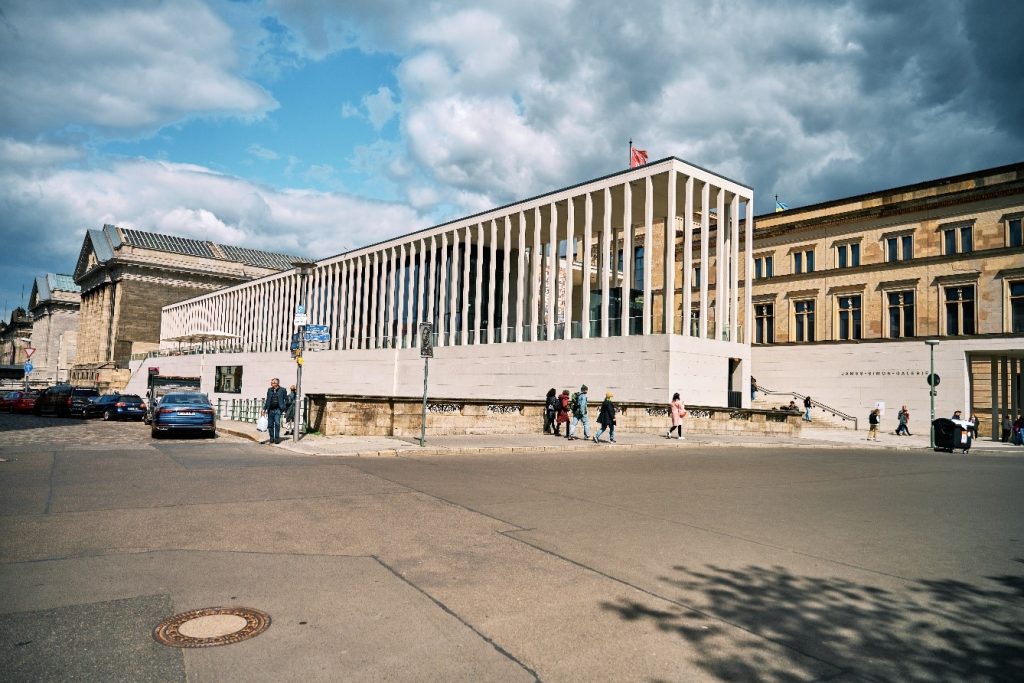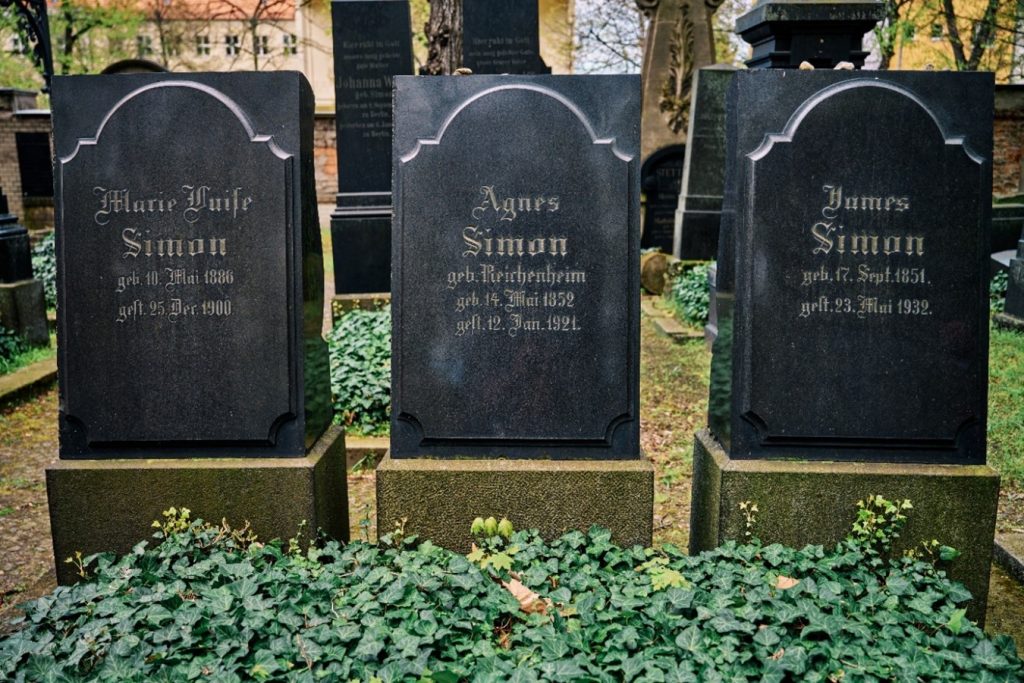4. Dezember 2023, by Benjamin Scheel
The Deutsche Orient-Gesellschaft (DOG) was founded on January 24, 1898 with the aim of promoting and carrying out archaeological research and archaeological excavations in the regions of ancient Mesopotamia (consequently in today’s West Asian countries). The society thus celebrates its 125th anniversary this year, including a public scientific colloquium and a commemorative publication this summer. Moreover, five years ago (2018) the James-Simon-Galerie was completed as the last and newest building on Berlin’s Museumsinsel and opened a year later (Fig. 1 and 2).


The building functions as the central visitor center of the Museumsinsel and offers space in its basement for exhibitions. It is named after James Simon, an important protagonist of the Berlin art and museum world in Wilhelminian times, who was also particularly important to the DOG. In today’s blog post I would like to give a short biographical sketch of the life of James Simon, his work in founding the DOG and his contributions to ancient West Asian archaeology.
Henri James Simon was born in Berlin on September 17, 1851, into a Jewish family that moved to Berlin from Posen (now Poznań). His father was a textile entrepreneur and cotton merchant who, together with his brother (Henri James’ uncle), founded the cotton company Gebrüder Simon in Berlin. The company benefited from the shortage and increase in the price of cotton in Germany and Europe triggered by the American Civil War (1861–1865) through its extensive stockpiling. Gebrüder Simon became the most important cotton company in Germany at this time. Although James Simon had a keen interest in ancient art and history, he began a merchant apprenticeship in the family business at his father’s instigation.
After his father’s death in 1890, Simon rose to the position of chief executive (alongside his uncle, and later his cousin Eduard). The company continued to prosper, eventually becoming one of the financially strongest and economically most powerful cotton companies in Europe around 1900, and James Simon himself was one of the wealthiest residents of Berlin and Prussia. Alongside his work as a businessman and entrepreneur, James Simon was a founder and supporter of several charities, including educational and social projects (e.g., the Verein für Ferienkolonien, the Verein für Volksunterhaltungen, the Verein zum Schutz der Kinder vor Misshandlung und Ausnutzung, and the Hilfsverein der deutschen Juden). In addition, however, he was also an art collector and an important patron of the Königliche Museen zu Berlin and other museum institutions. Since it was difficult for him, as a Jew in the Wilhelminian Empire, to become involved socially and politically in any other way, he made his impact on social and cultural policy by founding associations and providing financial support. In this way, he distinguished himself as a patriotic and left-liberal citizen of Berlin and Prussia (Fig. 3).

Since the 1890s, Simon focused his cultural-political activities on Western Asia. This happened at a time when the foreign policy of the Wilhelmine Empire was determined by the global political and imperialistic ambitions of Kaiser Wilhelm II. The German Empire was to expand into a political world power and become an imperialist competitor to France and Great Britain. A critical component of this new policy was the development of new colonies. These aspirations were to be fulfilled by the political and economic development of Mesopotamia (then part of the Ottoman Empire). The colonization of Mesopotamia promised access to oil sources and the Persian Gulf. For this purpose, the Ottoman Empire was economically and militarily bound to the German Empire through the dispatch of military advisors and the treaty for the construction of the so-called Bagdadbahn. Alongside these colonialist endeavors in Mesopotamia, cultural-political considerations soon joined in. Wilhelm II and broad circles of German classical scholarship and the interested public agreed that the “Alte Orient” should also be opened up scientifically.
Simon became a member of the so-called Orient-Comité. This committee was established in 1887/1888 with the goal of exploring the “Ancient Orient” by financing archeological excavations and the resale of the found archeological objects to the Königliche Museen at net cost price. However, the museums could not permanently afford to pay the purchase prices for the archaeological objects. As a result, the committee no longer had sufficient funds to continue financing the excavations. Simon criticized the committee’s business model and finally resigned from the Orient-Comité. Subsequently, Simon began preparations to establish a new and more efficient excavation organization that would work closely with the Königliche Museen. Furthermore, in September 1897, Simon financed an expedition planned by the Preußische Akademie der Wissenschaften and the Kommission zur Erforschung der Euphrat- und Tigris-Länder, in which the architect Robert Koldewey (1855–1925) and the orientalist Eduard Sachau (1845–1930) were to identify suitable excavation sites in Mesopotamia. In October 1897, Simon, the egyptologist Adolf Erman (1854–1937) and the archaeologist Alexander Conze (1831–1914) published a circular in which they called for the founding of a new and more efficient excavation society, the DOG. Among others, the two famous and influential ancient historians Theodor Mommsen (1817–1903) and Eduard Meyer (1855–1930) joined this appeal with their signatures. Finally, the foundation of the DOG took place in the Ägyptischen Säulensaal of the Neues Museum on 24th of January, 1898.
Due to his high social standing and his good contacts in business and politics, Simon was able to win many wealthy and influential members and supporters for the DOG. Besides James Simon, who officially only held the position of one of the society’s treasurers, I would like to mention Friedrich von Hollmann (1842–1913) and Bruno Güterbock (1858–1940) as other important early members of the DOG. Friedrich von Hollmann was a former admiral and Prussian secretary of state and acted for the DOG, first as deputy chairman and later as first chairman. He was a friend and confidant of Wilhelm II, whom he often informed about the efforts of the DOG and from whom he successfully solicited financial support for the society. This culminated in 1901 when the emperor became the so-called “Protektor” of the DOG and provided financial support for the society on a regular basis. Already a year earlier, Simon and von Hollmann, through persistent “lobbying”, obtained an annual contribution from the Prussian House of Representatives for the activities of the DOG.
Bruno Güterbock came from a wealthy Jewish banking family, earned a doctorate on Latin loanwords in Irish, and was baptized a protestant in 1879. From 1901 on he acted as secretary of the DOG. In this capacity he functioned as an excavation and scientific organizer. In 1936, Güterbock resigned from his position as secretary of the DOG as a direct result of the Nazi takeover and the introduction of the Nürnberger Gesetze of 1935 with which the Nazis sought to provide a legal foundation for their racist and anti-Semitic ideology. In addition to Güterbock’s resignation, the DOG also suffered the loss or resignation of its numerous other members of Jewish origin and religion during this period.
It is also noteworthy, that Güterbock functioned as editor of the Mitteilungen der Deutschen Orient-Gesellschaft and the Wissenschaftlichen Veröffentlichungen der Deutschen Orient-Gesellschaft. In addition, Güterbock also organized the famous and sometimes sensational annual lecture evenings of the DOG. These were held at the Berliner Singakademie from 1901 on and were attended by Wilhelm II from 1902 to 1914, making these events some of the most important societal occasions in imperial Berlin. Simon conceived these lectures to present the latest excavation results of DOG-funded research projects to a broad public, and in turn, to attract more members and funds to the DOG.
After the completion of the above-mentioned Mesopotamia expedition by Koldewey and Sachau in May 1898, the board of the newly founded DOG met to discuss the results of the expedition. It was agreed that Babylon would be the site of the first German excavation in Mesopotamia. The excavations in Babylon under the direction of Robert Koldewey were financed and organized by the DOG and began work already in March 1899. The excavations in Babylon lasted until 1917 and were the first to use historical and stratigraphic methods, which was to have a major impact on 20th-century archeology.
According to these scientific methods, the focus of the archaeological excavation was no longer the search for ancient works of art or other supposed archaeological “treasures”, but rather the architectural history and topographical development of ancient cities. Other vital DOG projects before World War I were the excavation in Assur from 1903 to 1914, as well as archaeological field research projects in Palestine and Egypt, which were mainly financed privately by James Simon.
World War I ended with the defeat of the German Empire and the abdication of Wilhelm II. The Weimarer Republik was the first German parliamentary democracy and became the state successor to the German Empire, ending its colonial and imperialist ambitions. At this time, James Simon was involved with the liberal Deutsche Demokratische Partei, his company, however, did not expand further since it ran into economic difficulties due to poor decisions by the company management and rising inflation. At the time of the Weimarer Republik, the DOG was also economically weak as well as scientifically, culturally, and politically isolated, so further field research was not possible. At that time, the scientific focus of the society was the publication of the wide variety of scientific discoveries that had been made in the previous decades as part of the archaeological fieldwork. James Simon died on May 23, 1932 and was buried in the Jewish Cemetery on Schönhauser Allee in Berlin (Fig. 4).

He died before the Nazis established their terror regime, initiated the persecution and extermination of the Jews and triggered World War II. The Nazis made Simon’s services to the collections of the Museumsinsel unrecognizable by removing Simon’s foundations as well as plaques and tributes to James Simon in the exhibition rooms of the museums, thus leaving him forgotten.
The commemoration of Simon has grown in recent decades with the publication of Olaf Matthes’ work on the patronage of James Simon and other publications dealing with Jewish patronage in the Wilhelmine Empire. By naming the visitor center of the Museumsinsel after James Simon, the Staatliche Museen zu Berlin (as successorof the Königliche Museen zu Berlin) has created an enduring memorial to one of their most influential and important benefactors and donors.
Bibliography
S. Böhme, Die Goldene Leibniz-Medaille, eine Grußblatt-Sammlung, eine „Festschrift“ sowie ein Exlibris und die „deutsche Wissenschaftstradition“. Späte Ehrungen für Bruno Güterbocks (1858-1940) „unendliche Arbeit“ als Schriftführer der DOG im Jahr 1928, in: J. Marzahn – F. Pedde (Hrsg.), Hauptsache Museum. Der Alte Orient im Fokus. Festschrift für Ralf-B. Wartke (Münster 2018), 311–329
E. Cancik-Kirschbaum, Henri James Simon zur 150. Wiederkehr seines Geburtstages, MDOG 133, 2001, 5–6
N. Crüsemann, Ein Vorläufer der DOG. Das Orient-Comité, in: G. Wilhelm (Hrsg.), Zwischen Tigris und Nil. 100 Jahre Ausgrabungen der Deutschen Orient-Gesellschaft in Vorderasien und Ägypten (Mainz 1998), 13
T. W. Gaehtgens, Die Berliner Museumsinsel im Deutschen Kaiserreich. Zur Kulturpolitik der Museen in der wilhelminischen Epoche (München 1992)
C.-M. Girardet, Jüdische Mäzene für die Preußischen Museen zu Berlin. Eine Studie zum Mäzenatentum im Deutschen Kaiserreich und in der Weimarer Republik Egelsbach 1997)
S. Hofmeister, Unter den neuen Kolonnaden. James-Simon-Galerie, in: F. Heilmeyer – S. Hofmeister (Hrsg.), Berlin. Urbane Architektur und Alltag seit 2009 (München 2022), 63–72
F. Kaltenbach, James-Simon-Galerie, Berlin, DE, in: S. Hofmeister (Hrsg.), David Chipperfield Architects3. Architektur und Baudetails (München 2022), 54–63
O. Matthes, Eduard Meyer und die Deutsche Orient-Gesellschaft, MDOG 128, 1996, 172–218
O. Matthes, Der Aufruf zur Gründung der Deutschen Orient-Gesellschaft vom November 1897, MDOG 130, 1998, 9–16
O. Matthes – J. Althoff, Die ‘Königliche Kommission zur Erforschung der Euphrat- und Tigrisländer‘, MDOG 130, 1998, 241–254
O. Matthes, Bruno Güterbock und Ulrich von Wilamowitz-Moellendorff, in: B. Böck – E. Cancik-Kirschbaum – T. Richter (Hrsg.), Munuscula Mesopotamica. Festschrift für Johannes Renger (Münster 1999), 277–284
O. Matthes, Friedrich von Hollmanns Bedeutung für die Deutsche Orient-Gesellschaft, MDOG 131, 1999, 191–208
O. Matthes, James Simon. Mäzen im Wilhelminischen Zeitalter (Berlin 2000)
E. Meyer, Fünfundzwanzig Jahre Deutsche Orient-Gesellschaft, MDOG 62, 1923, 1–25
E. von Schuler, Siebzig Jahre Deutsche Orient-Gesellschaft, MDOG 100, 1968, 6–22
A. Schwarz, Weiterbauen auf der Museumsinsel. Zum Entwurf der James-Simon-Galerie, in: E. M. Froschauer – W. Lorenz – L. Rellensmann – A. Wiesener (Hrsg.), Vom Wert des Weiterbauens. Konstruktive Lösungen und kulturgeschichtliche Zusammenhänge (Basel 2020), 249–254